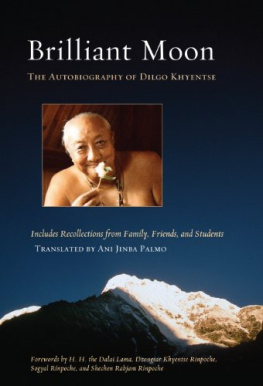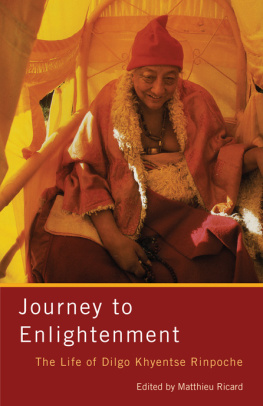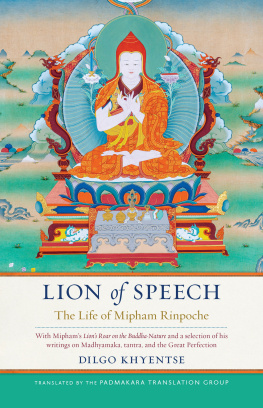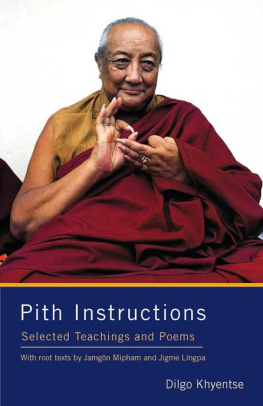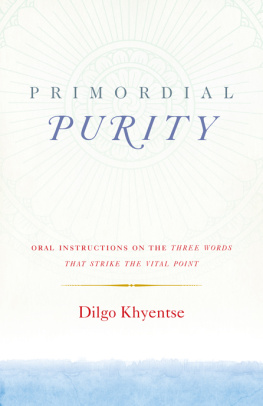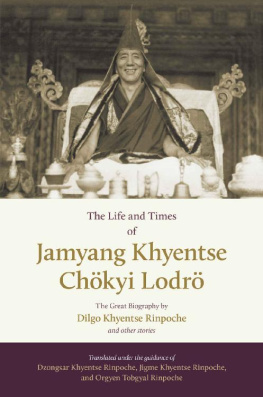It gives me immense pleasure to know that this authentic account of the life and activities of Dilgo Khyentse Rinpoche, whom I am fortunate to revere among my own precious teachers, has been prepared to remind those who knew him and inform those who did not.
His Holiness the Fourteenth Dalai Lama
He was a great leader, and just like a majestic American Indian chief or a distinguished samurai general, Dilgo Khyentse Rinpoche was never affected by chaotic or difficult circumstances, however tumultuous. He always remained quite still, like a mountain, effortlessly exuding an all-pervasive confidence that evoked confidence in those around him, and an absolute, unshakeable equanimity.
Dzongsar Khyentse, author of What Makes You Not a Buddhist
ABOUT THE BOOK
Through lively anecdotes and stories this highly revered Buddhist meditation master and scholar tells about his life of study, retreat, and teaching. The formative events of Dilgo Khyentse Rinpoches life, and those insights and experiences that caused him to mature into the warm, brilliant, and highly realized meditation master and teacher he was, are deeply inspiring. The second half of the book comprises recollections by his wife; his grandson, Shechen Rabjam Rinpoche; Tenga Rinpoche; the Queen Mother of Bhutan; and many prominent teachers.
DILGO KHYENTSE RINPOCHE (19101991) was a highly accomplished meditation master, scholar, and poet, and a principal holder of the Nyingma lineage. His extraordinary depth of realization enabled him to be, for all who met him, a foundation of loving-kindness, wisdom, and compassion. A dedicated exponent of the nonsectarian Ri-me movement, Khyentse Rinpoche was respected by all schools of Tibetan Buddhism and taught many eminent teachers, including His Holiness the Dalai Lama. He tirelessly worked to uphold the Dharma through the publication of texts, the building of monasteries and stupas, and by offering instruction to thousands of people throughout the world. His writings in Tibetan fill twenty-five volumes.
Sign up to learn more about our books and receive special offers from Shambhala Publications.

Or visit us online to sign up at shambhala.com/eshambhala.

Brilliant Moon
The Autobiography of Dilgo Khyentse
Translated and compiled by
Ani Jinba Palmo
Edited by Michael Tweed
Forewords by
His Holiness the Dalai Lama, Dzongsar Khyentse Rinpoche, Sogyal Rinpoche, and Shechen Rabjam Rinpoche

S HAMBHALA
BOSTON & LONDON
2012
Shambhala Publications, Inc.
Horticultural Hall
300 Massachusetts Avenue
Boston, Massachusetts 02115
www.shambhala.com
2008 by Shechen Publications
Introduction by Sogyal Rinpoche 2007 by the Tertn Sogyal Trust
Photographs 2, 3, 10, 11, 20, 25, 26, 27, 28, 29, 30, 31, 33, 34, 35, 36 Matthieu Ricard.
Photograph 21 Babeth Van Loo; photograph 22 Lodro Thaye; photograph 24 Lynn
Weinberger; photograph 32 Marilynn Silverstone.
All other photographs: photographer unknown.
All rights reserved. No part of this book may be reproduced in any form or by any means, electronic or mechanical, including photocopying, recording, or by any information storage and retrieval system, without permission in writing from the publisher.
The Library of Congress catalogues the hardcover edition of this book as follows:
Rab-gsal-zla-ba, Dis-mgo Mkhyen-brtse, 19101991.
Brilliant moon: the autobiography of Dilgo Khyentse / forewords by the Dalai Lama, Dzongsar Khyentse, Shechen Rabjam, and Sogyal Rinpoche; translated and compiled by Ani Jinba Palmo; edited by Michael Tweed.1st ed.
p. cm.
Includes bibliographical references.
eISBN 978-0-8348-2348-8
ISBN 978-1-59030-284-2 (hardcover: alk. paper)
ISBN 978-1-59030-763-2 (paperback: alk. paper)
1. Rab-gsal-zla-ba, Dis-mgo Mkhyen-brtse, 19101991. 2. LamasChinaTibetBiography. I. Palmo, Ani Jinba. II. Tweed, Michael. III. Title.
BQ982.A25A3 2008
294.3923092dc22
[B]
2008017295
Contents

S INCE THE TIME of the Buddha Shakyamuni himself, there has been a strong Buddhist tradition of recollecting the lives of great teachers and practitioners both as a mark of gratitude and appreciation and as a source of inspiration from which we may still learn. It gives me immense pleasure to know, therefore, that this authentic account of the life and activities of Kyabje Khyentse Rinpoche, who I am fortunate to revere among my own precious teachers, has been prepared to remind those who knew him and inform those who did not of his great qualities.
We first met, propitiously as it turned out, in the Jokhang in Lhasa, when I was just returning from my first pilgrimage to India. However, I did not really get to know him well until much later when we were both living in exile. Characteristically for this great and warmhearted man, he showed tremendous kindness to me in opening up his treasury of experience and knowledge in granting me empowerments, teachings, and transmissions.
Of course, one of the great qualities of the biographies of great beings such as Khyentse Rinpoche is to remind us of what it took for them to become the way they were. Most of us alive today will remember him for the great warmth of his presence, his ever-alert and attentive concern for others, imagining he was always like that. But even great lamas have to work to transform themselves and Khyentse Rinpoche was no exception. From his youth he applied himself unceasingly to study, practice, and teaching, he spent nearly a quarter of his life in retreat, and he kept up that pattern to the end of his life. He was so used to it, he made it look easy. The story of what it took is recorded here.
Traditionally we say that one of the Lamas principal kindnesses is simply his edifying presence here among us. I have no doubt that Kyabje Dilgo Khyentse Rinpoche was among the most accomplished Buddhist masters I have met, yet at the same time he radiated all the warm, uplifting qualities of a genuinely and thoroughly good human being, and as such achievements lie at the heart of Tibets rich and ancient culture, I think I can say that he was naturally an exemplary Tibetan too. It was a great privilege to have known him; I am sure readers will derive great benefit from becoming acquainted with him to some extent through this book.

Tenzin Gyatso, the Fourteenth Dalai Lama
April 20, 2007
Dharamsala, India

H OWEVER SIMPLY I try to tell the story of Dilgo Khyentse Rinpoches life, however understated my presentation of his vast legacy, I already know that the current generation of students will find it very hard to believe that just one person could accomplish so much in a single lifetime. Yet fantastic tales are an intrinsic part of the Buddhist tradition, and the Mahayana sutras and tantric texts are full of astonishing accounts of the hardship and difficulties that great bodhisattvas of the past had to overcome in order to receive teachings and to practice, as well as descriptions of the vast number of activities great masters engaged in during their lifetimes. Some of the more recent examples are the great Ri-me masters Jamyang Khyentse Wangpo and Jamgn Kongtrl Lodro Thaye, who transformed and revitalized Tibetan Buddhism in the nineteenth century. We can only marvel at the immensity of their output. The amount of texts they wrote alone is so numerous that its hard to believe that they did anything else in their lives but write; similarly, the list of teachings they received is so long, one wonders how they could have done anything else; and yet they also gave an incredible number of teachingsmore, one would have thought, than its possible to give in one lifetime.
Next page
